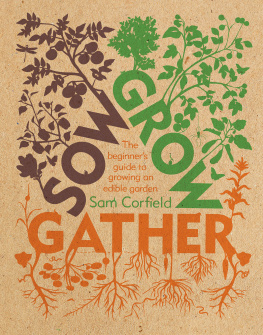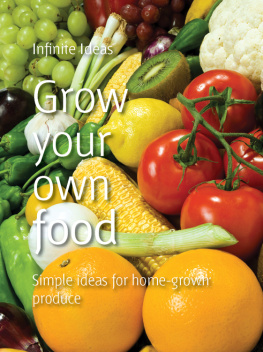Sugar Snaps & Strawberries

SUGAR SNAPS & STRAWBERRIES
Simple Solutions for Creating
Your Own Small-Space Edible Garden

BY Andrea Bellamy
WITH PHOTOGRAPHS BY Jackie Connelly


To my daughter, Lila,
and future gardeners everywhere.
CONTENTS
PREFACE
All around us, a movement is taking place. People are rigging up window boxes for growing herbs, making room on the fire escape for a pot of tomatoes, renovating neglected flowerbeds to make way for raspberries and rhubarb, and convincing landlords to turn over a few square feet of lawn for food production. Families are joining waitlists for community garden plots, signing up for canning workshops, and getting to know their local growers at the farmers market.
The economy, self-sufficiency, sustainability, taste, healthwhatever your reasons, it is always a good time to grow your own organic food. And you can do it, no matter how small your gardening space.
I grow food for all these reasons, but most of all I do it because it feels great. I love working outside and getting my hands dirty. I love connecting with other gardeners and sharing seeds and ideas. And I love harvesting something I have grown and eating it fresh that night for dinner. Yes, it is local foodreally local food. But mainly its just good food.
For me, gardening has been a lifelong obsession and an experiment in trial and error. Lots of error. And, believe it or not, that is something I love about growing foodit keeps me on my toes. Just when I think Ive finally mastered this urban farming thing, nature proves me wrong. The key, I think, is to pay attentionto celebrate each perfect potato, learn from mistakes, and, above all, enjoy the process.
This book walks you through the basicsand then someof planning, creating, and tending an organic food garden in a small space. This is the book I wish I had when I was a new gardener, and I hope it will be a helpful resource and an inspiration to you. Most of all, I hope you get hooked on gardening and growing your own good food.


ACKNOWLEDGMENTS
This book would never have been written without the love and support of my husband, Ben. Thank you for everything, honey.
I am also eternally grateful to my parents, Bill and Sandi Bellamy. In addition to introducing me to the pleasures of gardening and good food, they were instrumental in giving me the time and support I needed to write. Thank you.
I would also like to give a big shout out to HeavyPetal.ca readers for their encouragement and enthusiasm. I love the cross-pollination of ideas weve got going!
Thanks are also due to Caitlin and Owen Black, Carole Christopher, City FarmerVancouver Compost Demonstration Garden, Matt Kilburn, Lorey Lasley, Pat Logie, the Society Promoting Environmental Conservation, UBC Farm, and Nancy Zbik for letting us photograph their beautiful gardens. Special thanks to Caitlin Black at Aloe Designs, Bill Chalmers at Western Biologicals, Richard Reynolds of GuerrillaGardening.org, Rin at the Farmhouse Farm, and Maninder Tennessey at Atlas Pots for sharing your time and expertise. Thanks to Leslie Courchesne, Randy Friesen, and Vivian Garfinkel for helping me find the time to write. And thanks to my friends for just being there.
Thanks to Jackie Connelly for the amazing photography.
Thanks to the gang at Timber Press, especially Juree Sondker.
And, finally, Id like to thank worms for doing so much of the grunt work. You guys rock.

1 GARDEN STYLE
Not all that long ago, vegetable gardens were relegated to the backyard. Tucked away from the eyes of neighbors and visitors, the veggie patch was often plain and utilitarian. It served one function: to feed the family.
Now, edibles are everywhereeven on the grounds of the White House. And not only gardeners are doing the growing. Foodies are discovering the beauty of cooking with homegrown produce and herbs. Self-sufficient types are learning how to feed themselvesfrom seed to plate. And we are all trying to lighten our carbon footprint and save money by eating closer to home. Finally, the veggie patch is having its day.

There is beauty in a garden, no matter how simple or how small.
Few of us have a spare 200 square feet in which to hide a vegetable garden. In a small spacebe it a balcony, a patio, a plot in a community garden, or even a small yardeverything is right there in front of you. So forget about segregating your ediblescelebrate them! Put your veggie patch on display. Youre living with itand, in summer, practically in itso you may as well design your edible garden to be beautiful as well as functional.
You might be entering the food-growing game for reasons not too different from those of your grandparents. You might just want a basic, yet productive, vegetable patch from which to supplement your meals. But even a no-frills approach to food gardening can be attractive. It starts with a bit of dreaming and planning, which is what this chapter is all about.
FINDING YOUR PERSONAL STYLE
Deciding how you want your garden to look can be a difficult task. You might find yourself drawing a blankor having many differing visions of your personal paradise.
Take a moment to disregard the reality of your space. Forget its limitations. Let your mind wander and think about your dream garden. What do you imagine? It could be the charming, formal kitchen garden at a bed and breakfast you visited in France. It could be your grandfathers sun-drenched veggie patch behind the old house, or the casual luxury of the penthouse suite deck you can see from your balcony.
Finding and embracing these inspirations will set the theme, or mood, of your garden. And although you might not be able to duplicate your dream garden at home, you can use its characteristics to influence your garden design.
You may not have room for a traditional potager, for example, but you can incorporate touches of this time-honored French kitchen garden design into any space. Choose weathered terracotta or metal planters, planting one with boxwood (Buxus sempervirens), the evergreen shrub traditionally used to hedge in a potager, to provide structure and year-round greenery. Your choice of plants (attractive edibles combined with ornamental flowering plants) and structure (formal and geometrical rather than informal and asymmetrical) will all hint at the theme of your garden space.
Next page











